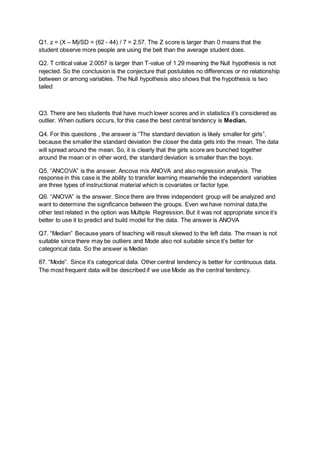
answer
- 1. Q1. z = (X – M)/SD = (62 - 44) / 7 = 2.57. The Z score is larger than 0 means that the student observe more people are using the belt than the average student does. Q2. T critical value 2.0057 is larger than T-value of 1.29 meaning the Null hypothesis is not rejected. So the conclusion is the conjecture that postulates no differences or no relationship between or among variables. The Null hypothesis also shows that the hypothesis is two tailed Q3. There are two students that have much lower scores and in statistics it’s considered as outlier. When outliers occurs, for this case the best central tendency is Median. Q4. For this questions , the answer is “The standard deviation is likely smaller for girls”, because the smaller the standard deviation the closer the data gets into the mean. The data will spread around the mean. So, it is clearly that the girls score are bunched together around the mean or in other word, the standard deviation is smaller than the boys. Q5. “ANCOVA” is the answer. Ancova mix ANOVA and also regression analysis. The response in this case is the ability to transfer learning meanwhile the independent variables are three types of instructional material which is covariates or factor type. Q6. “ANOVA” is the answer. Since there are three independent group will be analyzed and want to determine the significance between the groups. Even we have nominal data,the other test related in the option was Multiple Regression. But it was not appropriate since it’s better to use it to predict and build model for the data. The answer is ANOVA Q7. “Median” Because years of teaching will result skewed to the left data. The mean is not suitable since there may be outliers and Mode also not suitable since it’s better for categorical data. So the answer is Median 87. “Mode”. Since it’s categorical data. Other central tendency is better for continuous data. The most frequent data will be described if we use Mode as the central tendency.